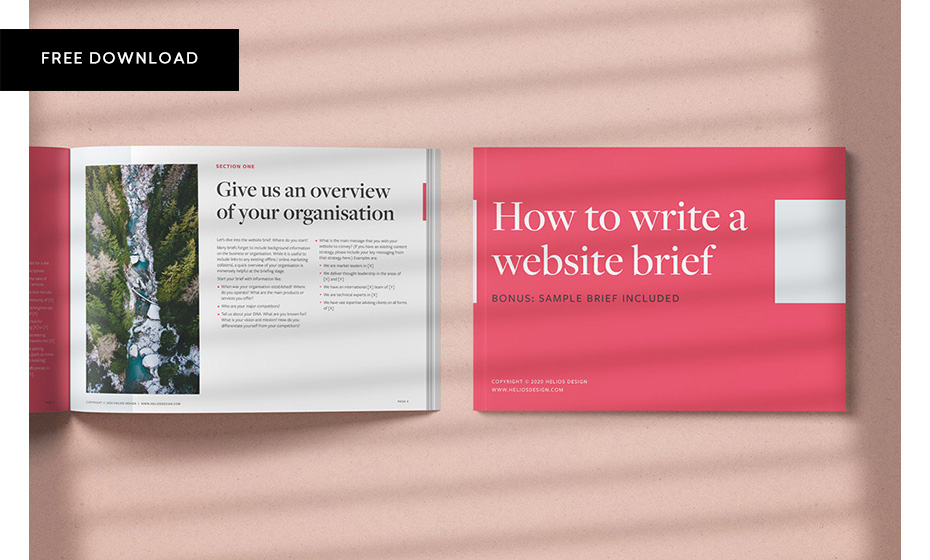How to write a website brief (with sample brief)
Your road map to digital success

Last modified
When it’s time to build your website, a detailed website brief is your road map to success.
What is a website brief?
A website brief is a document that outlines your project's goals, requirements and contraints. It gives prospective web services provider a clear picture of whether they are the right fit for your project, and what the project timeline and budget will be.
In short, a detailed brief:
- Gives clarity to the project scope
- Saves time on the project discovery phase
- Reduces the risk of costly assumptions
Download our free guide

Download our free website
briefing guide (bonus
sample brief included).
Your website brief checklist
- Give us an overview of your organisation
- Give us an overview of the problems you are solving
- Tell us about your target audience
- Include a competitor analysis
- Outline the website scope and features
- Outline project responsibilities
- How will you measure success?
- Include legal and technical requirements
- Outline the project timeline, key contacts and agency requirements
Let’s dive into the details.
1. Start with an overview of your organisation
One of the most common mistakes in briefs is leaving out essential background information on the business or organisation. While links to existing marketing materials (online or offline) are useful, a quick overview of your organisation is immensely helpful at the briefing stage.
Start your brief with information like:
- When was your organisation established? Where do you operate? What are the main products or services you offer?
- Tell us about your DNA. What are you known for? What is your vision and mission? How do you differentiate yourself from your competitors?
- What is the main message that you wish your website to convey? (If you have an existing content strategy, please include your key messaging from that strategy here.) Examples are:
- We are market leaders in [X]
- We deliver thought leadership in the areas of [X] and [Y]
- We have an international [X] team of [Y]
- We are technical experts in [X]
- We have vast expertise advising clients on all forms of [X]
2. Give us an overview of the problems you are solving
Now that we know who you are and what you stand for, it’s time to tell us more about the overarching business problem you want your website to solve.
If you are building a new site, we want to know:
- Are you hoping for the website to drive sales? Build brand awareness? Generate leads?
- What business function will the website support through its existence?
If you are revamping an existing site, what are your main reasons for doing so?
- Is the existing site dated? Does it have issues with traffic, stickiness or customer retention? Does it need to be refreshed to reflect an updated brand identity?
- What are the major paint points that users have described on the current website?
- What are your main likes and dislikes about your current web presence?
- Are there existing processes (such as billing, invoicing and content management) that could be streamlined or improved?
Pro tip: Here is our comprehensive guide on conducting a website audit.
Here are examples of high-level business goals for a site:
- Help raise the firm’s profile in the areas of [X]
- Reflect updated brand message of [X]
- Communicate our expertise and experience in [X]
- Rank alongside our competitors but differentiate us in terms of [X]
- Drive [X] amount of high-quality monthly leads
- Increase the scope of enquiries from [X] type of client
- Drive subscriptions
- Boost online sales of products / services
- Attract the best recruits
- Build a community of [X]
- Build and strengthen our network of [X]
- Serve as a hub for connecting [X] to [Y]
- Consolidate existing content channels into [X]
- Streamline existing processes (such as online billing and invoicing)
- Increase efficiencies in areas of [X]
3. Tell us about your target audience
 To create a website that addresses your goals, we need to get to know your target audience. Specifically, we would like to know:
To create a website that addresses your goals, we need to get to know your target audience. Specifically, we would like to know:
- What does your typical client look like?
- What sectors and geographies do they operate in?
- What are the main problems they are trying to solve when enlisting your services?
- Is your audience segmented into specific groups with different needs (e.g. clients, prospective employees, media and press)?
- What online user activity would you define as a “success”?
Examples of “success” could be:
- Purchase a product / subscription
- Sign up for a newsletter
- Contact a member of your team
- Access resources in a knowledge centre
- Sign up for events / webinars
- Fill out an enquiry / registration / quote form
4. Include a competitor analysis
Include a list of 5 direct competitors and 5 aspirational competitors. This information is helpful for the website strategy phase of the project.
If possible, include a list of likes and dislikes on competitor sites.
5. Outline the website scope and features
With a fuller picture of what you do, who your audience is, and what you want to achieve, it’s time to dive into the details of your prospective website. We consider this the ‘meat and potatoes’ of the brief because it’s where the technical and creative possibilities are addressed.
Please give us an outline – a rough draft is okay – of your prospective website navigation structure.
Next, please list the major features that need to be coded. Here is an example overview of potential features:
- User registration and login
- Member management interface
- Member restricted resources
- Ecommerce platform and online billing
- Blog or news platform
- Events and online bookings
- Knowledge centre
- Help desk
- Vacancy portal
- Search functionality
- Contact forms or other online forms
- PDF converter
- Interactive map
- Social media integration
- Multi-lingual platform
Where possible, please include a brief description of each feature, with links to online references.
Information is power, so you can never send us too many illustrative examples.
6. Outline project responsibilities
Who’s going to do what as we work together on this project? It’s time to outline the project responsibilities:
- Design: Does your firm have existing brand guidelines that dictate the suitable approach with regards to fonts, colours and photography, or do these need to be compiled as part of the project? Do you have other branding collateral (brochures, guides) that the site should tie in with?
- Content: Will you be writing the content for the website, or do you expect a web agency to provide copywriting services? Do you require assistance with the editing and proofreading of content?
- Imagery: Do you have professional photography available for the project, or does the project require custom photography services? Do you anticipate using stock photography / illustrations in the project?
- Translations: If the site is multi-lingual, do you require the services of a translation agency or will you provide all translated text?
- Post-launch marketing: What are your post-launch website marketing plans (e.g. PPC, social media marketing, email marketing) and do you need assistance with post-launch marketing efforts?
- Post-launch content updates: Do you require assistance managing the website content over time, or do you have an in-house team that will be responsible for post-launch content updates to the site?
If you’re not sure where some of the elements will come from yet, that’s okay. Let us know what pieces are missing, and we can help you source them.
7. How will you measure success?
 Imagine: your brand-new website is up and running. It’s fast, user-friendly and feature-rich. But is it solving the problems you articulated early on in your brief? There’s no way to find out without testing.
Imagine: your brand-new website is up and running. It’s fast, user-friendly and feature-rich. But is it solving the problems you articulated early on in your brief? There’s no way to find out without testing.
We would like to address success metrics at the briefing stage of a project. Here are examples you might want to consider:
- Google Analytics usage metrics
- Number of subscribers and their usage of the site
- Monthly increase in leads
- Scope of event registrations
- Scope of newsletter subscriptions
- Website rankings compared to competitors in a post-launch client survey
- Feedback from clients during project pitches
- Feedback from prospective job applicants
- Company press coverage
- Recognition from external bodies and industry awards
- Cost savings achieved as a result of specific online features
Ideally, the metrics used to measure your site’s success should be “SMART”: specific, measurable, attainable, relevant, and time-bound.
8. Include legal and technical requirements

Where are nearly there! Before you hit send, please give us an overview of legal and technical requirements relevant to your region.
Here are a few questions to get you thinking:
- Does the site need to meet WCAG or ADA accessibility requirements?
- Does it need to comply with EU cookie regulations and GDPR?
- Is there a specific platform it needs to tie in with? Do you have a preferred CMS?
- Do you have a preferred payment gateway when it comes to online billing?
- Do certain features of the site need to integrate with an existing CRM or accounting platform?
- Does the site require integration with third-party APIs?
- What are your hosting requirements, and do you have an existing hosting provider?
9. Outline the project timeline, key contacts and vendor requirements
For the concluding portion of your brief, please let us know when the project is due, how many people will be involved, and what you are looking for in a prospective agency.
Please outline the project timelines:
- What is the proposal due date?
- How long will you take to review the proposal and by when will you appoint an agency?
- What is the targeted project kick-off date?
- Do you have a target launch date? Should this be divided into specific project phases?
Please also tell us about your team:
- How many decision-makers will be involved in the project?
- Will the project have multiple points of contact or a single project manager at your firm?
- Who is the point of contact for questions surrounding the project brief?
Please tell us about your vendor requirements:
- What are you looking for in a web vendor?
- What skills and experise do they need to demonstrate?
- What aspects of the proposal are most important to you?
Send us a copy of your brief
Lastly, send us a copy of your website brief and we'd be happy to respond with a proposal.
Save this content
If you have not already done so, please download our briefing guide below with sample illustrative brief:

Frequently asked questions
How long will it take to write a website brief?
It typically takes 2-3 weeks to compile a detailed website brief. The more detailed your brief, the more time you can save later on during the project scoping phase.
How long should a website brief be?
A website brief should ideally be at least 4-10 pages long, covering the following topics:
- Company overview
- Project goals
- Target audience
- Competitor review
- Website scope and features
- Project responsibilities
- Legal and technical requirements
- Project timelines
That said, we have received briefs as short as two pages and as long as 80 pages! The more complex your project, the more detail you will probably wish to add to the brief.
What is the purpose of a website brief?
The purpose of a website brief is to establish the key goals and requirements of a web development project so that a prospective web vendor can respond with a detailed project proposal, outlining project costs and timelines.

If your website is in need of a refresh, please contact us to discuss your project. We’d love to connect.



